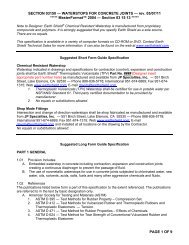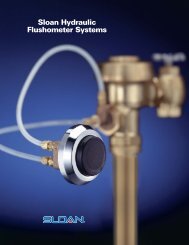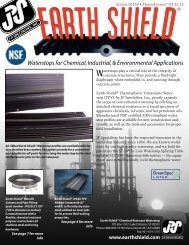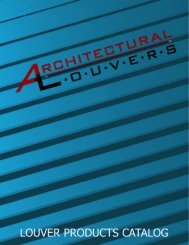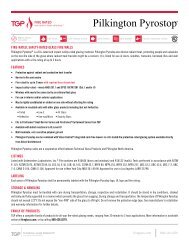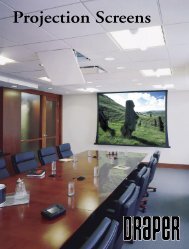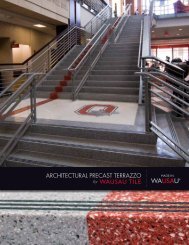National Gypsum Construction Guide
National Gypsum Construction Guide The entire - AECinfo.com
National Gypsum Construction Guide The entire - AECinfo.com
- No tags were found...
You also want an ePaper? Increase the reach of your titles
YUMPU automatically turns print PDFs into web optimized ePapers that Google loves.
2. Fire-Resistant: A gypsum core lathing board with<br />
additives to enhance the fire resistance of the core and<br />
surfaced with absorptive paper on front, and long edges<br />
and complying with ASTM C 588/C 1396, Type X.<br />
a. Thickness: 1/2" (Kal-Kore BRAND Fire-Shield C Plaster<br />
Base) or 5/8" (Kal-Kore BRAND Fire-Shield and Fire-<br />
Shield C Plaster Base).<br />
b. Width: 4'<br />
c. Length: 8' through 16'<br />
d. Edges: Tapered<br />
3. Regular, Foil-Backed: A gypsum core lathing board<br />
surfaced with absorptive paper on front, and long edges;<br />
backed with aluminum foil; and complying with ASTM C<br />
588/C 1396 (Kal-Kore BRAND Foil-Back Plaster Base).<br />
a. Thickness: 1/2"<br />
b. Width: 4'<br />
c. Length: 8' through 16'<br />
d. Edges: Tapered<br />
B. <strong>Gypsum</strong> Plaster:<br />
1. Base Plaster: <strong>Gypsum</strong> neat plaster complying with ASTM<br />
C 28 (Gold Bond BRAND Two-Way Hardwall <strong>Gypsum</strong><br />
Plaster).<br />
2. Base Plaster: <strong>Gypsum</strong> plaster with mill-mixed perlite<br />
aggregate complying with ASTM C 28 (Gold Bond BRAND<br />
Gypsolite Plaster).<br />
3. Finish Plaster: <strong>Gypsum</strong> gauging plaster complying with<br />
ASTM C 28 (Gold Bond BRAND Super-White Gauging<br />
Plaster Quick Set and Gold Bond BRAND Super-White<br />
Gauging Plaster Slow Set).<br />
4. Finish Plaster: <strong>Gypsum</strong> moulding plaster complying with<br />
ASTM C 59 (Gold Bond BRAND Super-White Moulding<br />
Plaster).<br />
5. Finish Plaster: <strong>Gypsum</strong> plaster for smooth finish<br />
complying with ASTM C 587 (Kal-Kote BRAND Smooth<br />
Finish Plaster).<br />
6. Finish Plaster: <strong>Gypsum</strong> plaster for textured finish<br />
complying with ASTM C 587 (Kal-Kote BRAND Texture<br />
Finish Plaster).<br />
7. Finish Plaster: <strong>Gypsum</strong> plaster for smooth finish<br />
complying with ASTM C 587 (Uni-Kal BRAND Veneer<br />
Plaster).<br />
8. Finish Plaster: <strong>Gypsum</strong> plaster for smooth finish<br />
with extended set time complying with ASTM C 587<br />
(X-KALibur BRAND Veneer Plaster).<br />
PART 3 EXECUTION<br />
3.01 INSTALLATION<br />
A. Metal Lath, <strong>Gypsum</strong> Lath, and Accessories: In accordance<br />
with ASTM C 841.<br />
B. <strong>Gypsum</strong> Plaster: In accordance with ASTM C 842 and the<br />
manufacturer’s recommendations, <strong>National</strong> <strong>Gypsum</strong><br />
Company “<strong>Gypsum</strong> <strong>Construction</strong> <strong>Guide</strong>.”<br />
C. Tolerances: For flatness of surface, do not exceed 1/4" in<br />
8' for bow or warp of surface and for plumb and level.<br />
®<br />
For additional information<br />
Phone 1-800-NATIONAL<br />
(1-800-628-4662)<br />
RECOMMENDATIONS<br />
BASECOAT PLASTER PROCEDURES<br />
Two-Coat Work<br />
Apply first coat with firm pressure to form good bond on the<br />
gypsum lath or masonry base; then immediately double back<br />
(without cross-raking first coat) using material of same<br />
proportion to build proper basecoat thickness. Straighten<br />
to a true surface (without applying water) to receive the<br />
second (finish) coat.<br />
Surface should be left sufficiently rough and porous to provide<br />
suitable bond of the finish coat.<br />
Three-Coat Work<br />
“Scratch” – “brown” – finish is generally used for metal lath or<br />
masonry bases, and is performed in discrete steps.<br />
• Scratch (first) coat: Should be applied with sufficient<br />
material and pressure to obtain good bond over solid<br />
bases or form full keys through metal lath. Provide<br />
suitable material thickness for scratching (raking) to<br />
obtain good mechanical keying of the “brown” coat.<br />
• Brown (second) coat: Shall be applied after the scratch<br />
(first) coat has set hard. Apply to give mass and surface<br />
as for double-back in two-coat work.<br />
Finish Coat Plaster Procedures<br />
General Requirements (Basecoat Condition)<br />
Application over a partially dry basecoat is preferred. If basecoat<br />
is thoroughly dry, wet with even application of water to a<br />
semi-dry condition. Avoid excess water. Do not apply finish<br />
to basecoats having free water on the surface.<br />
Application – Gauged Lime Putty Trowel Finish<br />
Smooth Finishes<br />
• Scratch in tightly over the basecoat, covering the<br />
surface completely, then double back immediately<br />
with material from the same gauge, filling out to a true,<br />
even surface with total thickness of not more than 1/16".<br />
• Allow finish to “draw” (lose moisture to basecoat and<br />
ambient air) and firm up – then trowel it well to<br />
compact and close the surface under the edge of the<br />
trowel. Dash water on the surface for lubrication and<br />
development of soft material along trowel’s edge to fill<br />
surface depressions or other blemishes.<br />
• When finish plaster setting action is under way, a<br />
second (final) water trowelling can be done with strong<br />
pressure to obtain a polished surface if desired.<br />
Texture Finishes<br />
• Apply finish as above to a true, even surface with total<br />
thickness not more than 1/8".<br />
• Allow finish to “draw” (lose moisture to basecoat and<br />
ambient air). Then begin floating, texturing, or skip<br />
trowelling to achieve desired texture. Additions of<br />
clean graded silica may be required to achieve<br />
desired texture.<br />
Drying<br />
Conventional plaster systems should be allowed to dry<br />
30 days minimum under ambient conditions prior to<br />
final decoration. Variances in humidity or poor drying<br />
conditions may affect the drying process.<br />
Storage<br />
<strong>Gypsum</strong> plaster must be kept dry before use.<br />
Storage conditions vary with location and<br />
seasonal changes, which may affect storage life.<br />
These conditions may affect product characteristics<br />
such as setting time, working qualities, component<br />
separation, or lumping, etc. Such aging is normally<br />
a function of exposure to humid air, temperature,<br />
and physical support in warehousing. Adverse storage<br />
conditions or prolonged storage may affect the working<br />
qualities of the product. Rotate inventory frequently for<br />
best results.<br />
40 NATIONAL GYPSUM LATH AND PLASTER SYSTEMS



